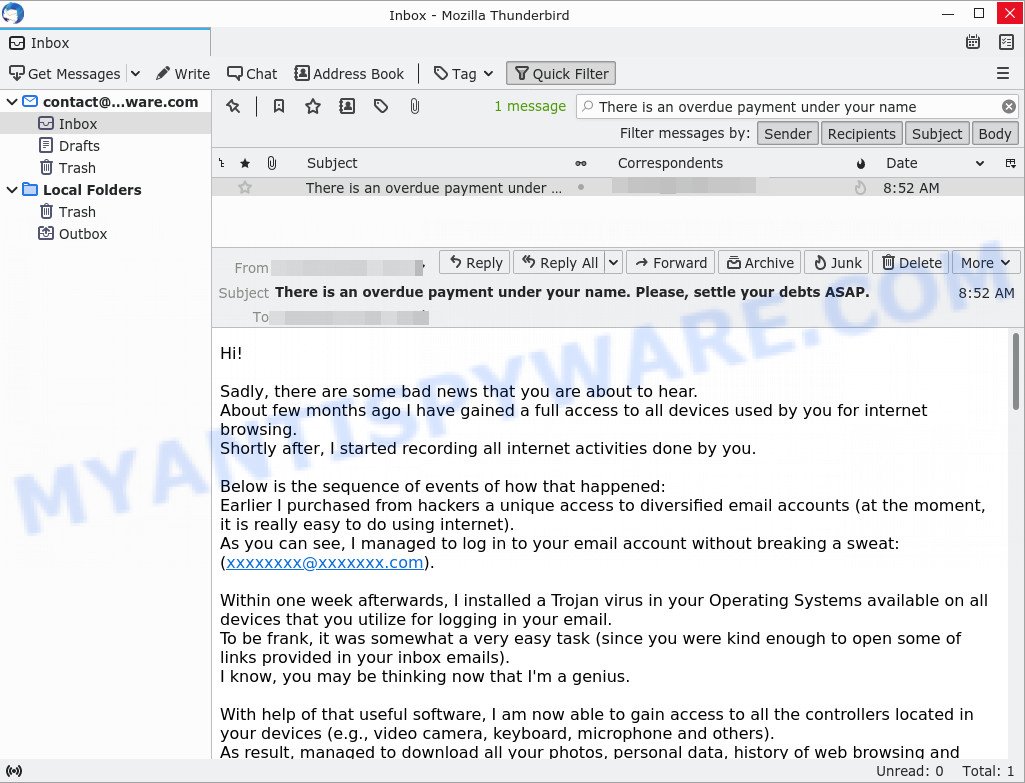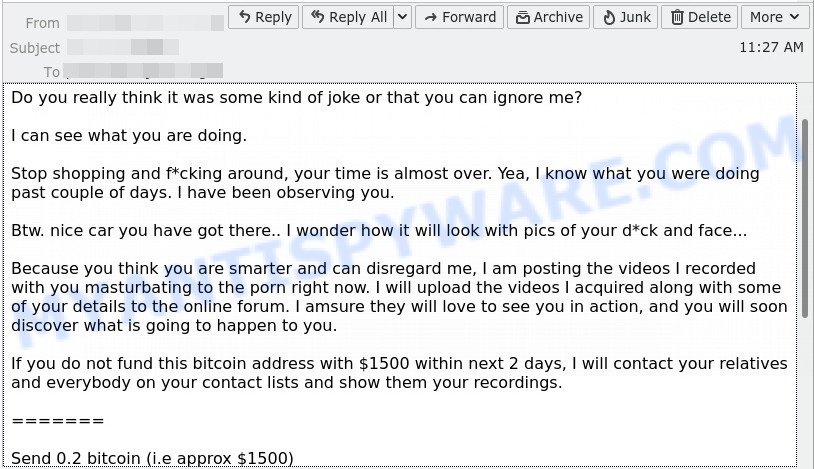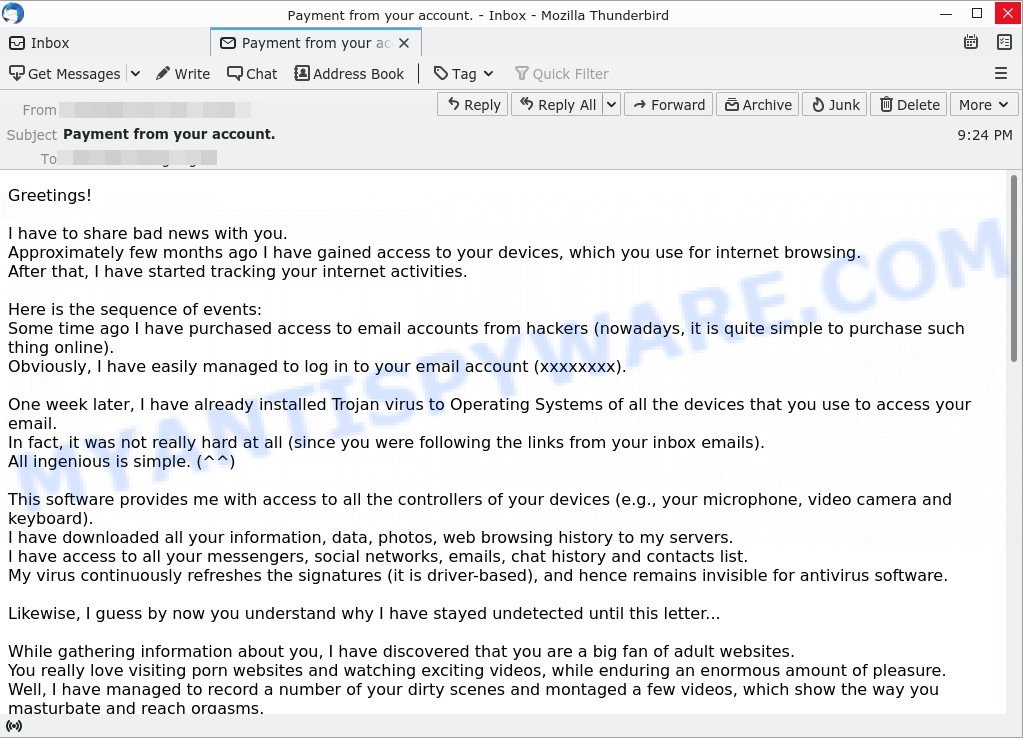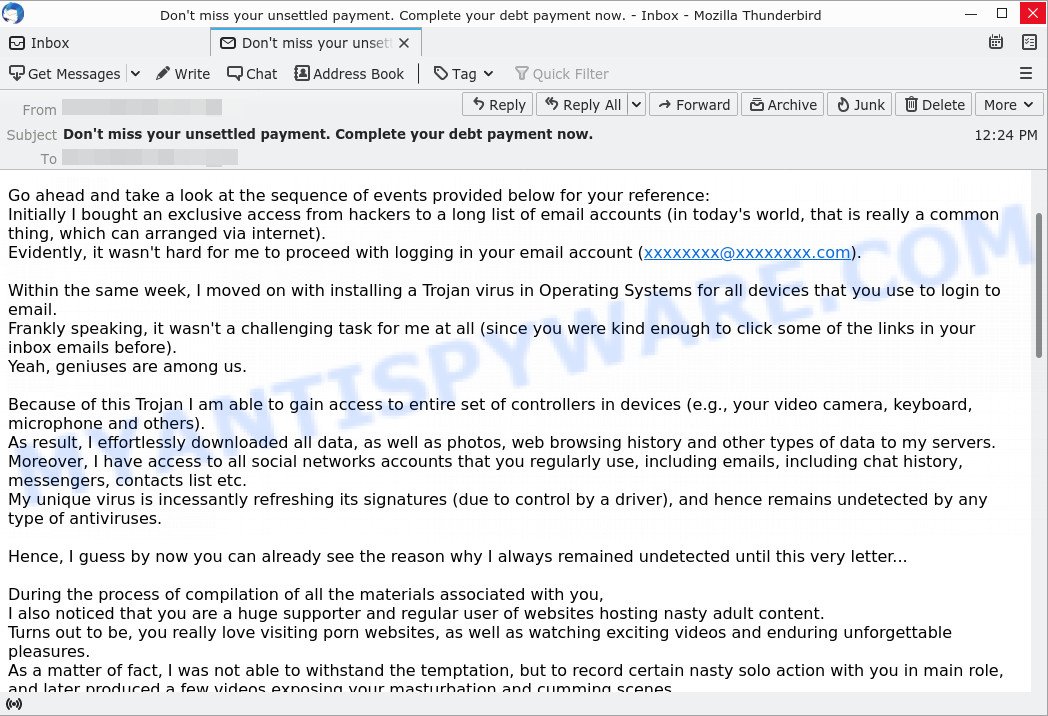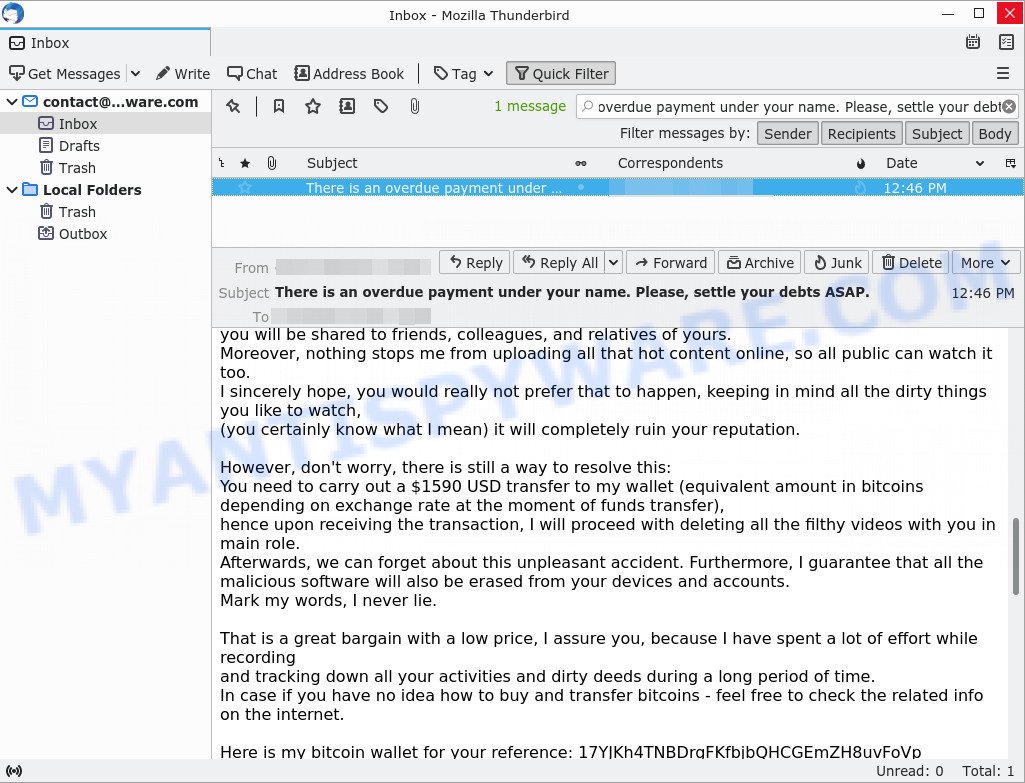What is “I hacked your device” Email Scam?
I hacked your device email is an online sextortion scam. Sextortion is another word for “sexual extortion”. Sexual extortion is a type of “phishing attack”, where scammers try to trick people into paying a ransom. Sextortion scam targets victims via Email/SMS/text messages. Scammers threaten to reveal intimate photos of their victims if the ransom is not paid.
Sextortion scam emails may contain a genuine password from one of the victim’s accounts. Usually passwords are appended to these messages as proof, that is, if the password was actually used by the victim, then what is described in the email is true. Scammers get these real passwords by buying them on darknet.
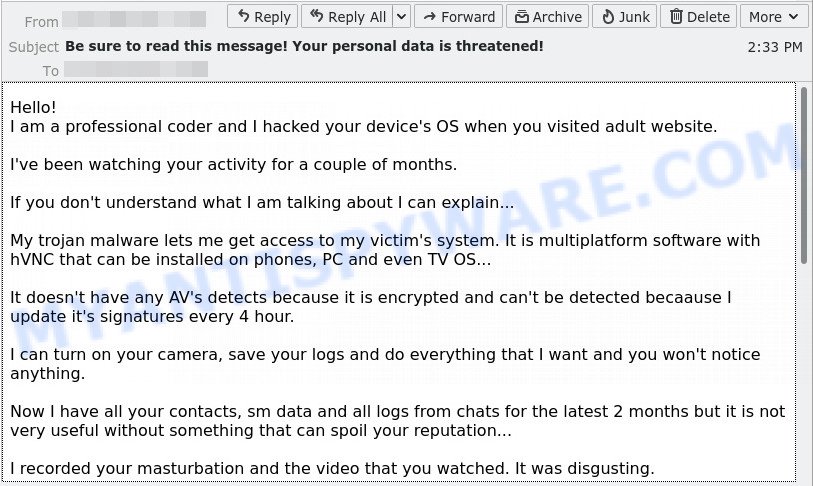
I hacked your device EMAIL SCAM
QUICK LINKS
- What is I have e-mailed you from your account SCAM?
- Should you pay?
- What to do when you receive the scam message?
- How to spot a phishing email?
- Report Scam Email
The Scam in detail
In this particular case, the scam email says that someone calling himself a professional coder has been watching the victim, because the victim’s computer has a virus, which is a Trojan that allows the attacker to completely control the computer and even record video from the computer’s camera. The scam email claims that a video was recorded showing the victim masturbating while browsing porn sites. This video will be sent to the victim’s friends if the victim does not pay the ransom to the bitcoin address provided in the email.
The scam email is not the only one of its kind, there are many similar ones. They all have similar features: statement that the victim’s computer and webcam were hacked, threats that the attackers recorded a compromising video, and a ransom demand. Explanations that scammers use to explain how they have access to your camera and privacy:
- They set up malware on adult (porn) website.
- They penetrated with “zero-click” vulnerability on Zoom or Pegasus.
- They got your credentials (login and password) from hackers.
Depending on the scam email, victims are given 24 to 48 hours to pay a ransom in Bitcoin. The sextortion emails also contain claims that the victim’s contact information was stolen, allegedly the hacker copied the victim’s contact list and social media credentials. And finally, Sextortion scams contain threats, the victims must pay a ransom, or compromising materials will be sent to their contacts.
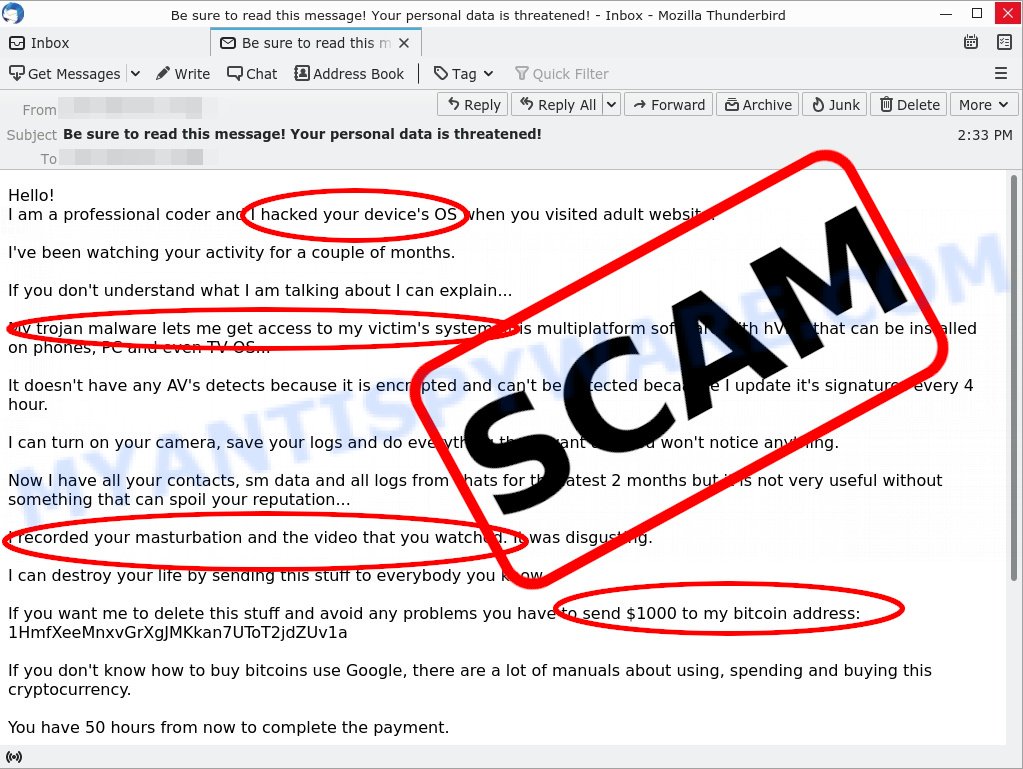
Typically, sextortion scams are sent via email, thousands at a time, and are part of larger spam campaigns. As with many other types of scams, scammers are evolving their methods to deliver their messages to potential victims. Such attacks can be personalized and sent out in smaller numbers to avoid detection. Scammers can use reputable services, change and personalize the content of each message, and avoid including links or attachments – all in an attempt to bypass security.
Text presented in the scam email:
Hello!
I am a professional coder and I hacked your device’s OS when you visited adult website.I’ve been watching your activity for a couple of months.
If you don’t understand what I am talking about I can explain…
My trojan malware lets me get access to my victim’s system. It is multiplatform software with hVNC that can be installed on phones, PC and even TV OS…
It doesn’t have any AV’s detects because it is encrypted and can’t be detected becaause I update it’s signatures every 4 hour.
I can turn on your camera, save your logs and do everything that I want and you won’t notice anything.
Now I have all your contacts, sm data and all logs from chats for the latest 2 months but it is not very useful without something that can spoil your reputation…
I recorded your masturbation and the video that you watched. It was disgusting.
I can destroy your life by sending this stuff to everybody you know.
If you want me to delete this stuff and avoid any problems you have to send $1000 to my bitcoin address: 1HmfXeeMnxvGrXgJMKkan7UToT2jdZUv1a
If you don’t know how to buy bitcoins use Google, there are a lot of manuals about using, spending and buying this cryptocurrency.
You have 50 hours from now to complete the payment.
I have a notification that you are reading this message… TIME HAS GONE.
Don’t try to respond because this email address is generated.
Don’t try to complain because this and my bitcoin address can’t be tracked down.
If I notice that you shared this message everybody will receive your data.
Bye!
Should you pay?
The best advice is: Don’t pay the ransom and do not reply! Sometimes scammers will escalate if you reply. If you receive the sextortion email scam, just ignore the scammers. The best way to deal with the scam email is simply to move it to trash!
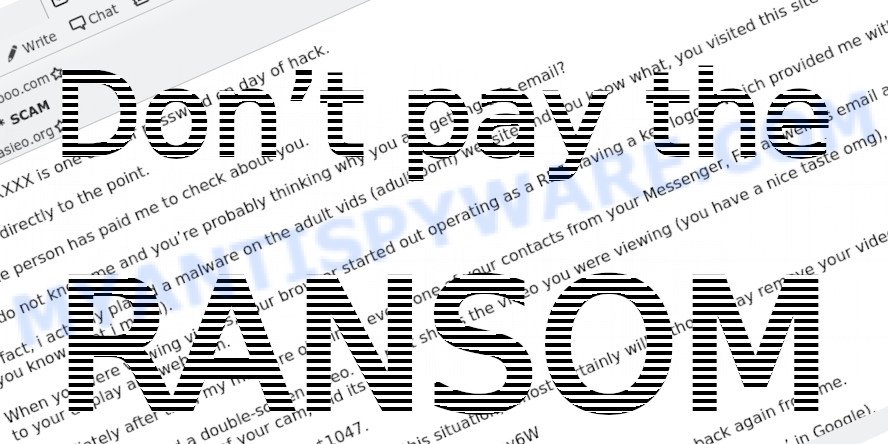
Threat Summary
| Name | I hacked your device SCAM |
| Type | Sextortion, Phishing, Bitcoin Email Scam, Fraud, Scam |
| Ransom amount | $1225, $1000 |
| Bitcoin Address | 1Dmh5VKGQcxThNADmmYewCdq3fxKxgkrMr, 133gp7wGpKFaB2C593B2MCk2G4abYnEj9j, bc1qugayfpsxsdl3hn3xnde0e835g4rucj7f8v0up4, 1HmfXeeMnxvGrXgJMKkan7UToT2jdZUv1a |
| Distribution method | spam email campaigns |
| Removal | If you received an email saying i hacked your device, our computer security experts recommend follow the steps below |
Examples of such scams
There are many sextortion scams circulating via email. Scammers often change the content of emails in order to deceive victims and bypass the security system. Unfortunately, there are some bad news for you, I have e-mailed you from your account, I have to share bad news with you are other examples of sextortion scams. Such emails are also often used to distribute ransomware, trojans, worms and other malware.
- The “Sadly, there are some bad news that you are about to hear.” email is a SCAM
- FINAL WARNING email is a sextortion scam
- “Payment from your account.” email is a ‘sextortion’ scam
- “Don’t miss your unsettled payment. Complete your debt payment now.” email is a SCAM
- “There is an overdue payment under your name. Please, settle your debts ASAP.” message us a SCAM
What to do when you receive the I hacked your device Scam Email
We advice to someone who gets this fraudulence message:
- Do not panic.
- Do not pay a ransom.
- Do not reply.
- Don’t open any attachments. It might contain malware.
- If there’s a link in the scam email, do not click it, otherwise you could unwittingly install malware or ransomware on your computer.
- Report the email spam to the FTC at https://www.ftc.gov/
- Scan your computer for malware.
- Install an anti-phishing software.
If you suspect that your computer is infected with spyware, you accidentally clicked on a link in the scam email, or just want to scan your computer for malware, then use one of the free malware removal tools.
How to spot a phishing email?
Phishing emails often share common characteristics; they are designed to trick victims into clicking on a phishing link or opening a malicious attachment. If you know these characteristics, you can detect phishing emails and prevent identity theft.
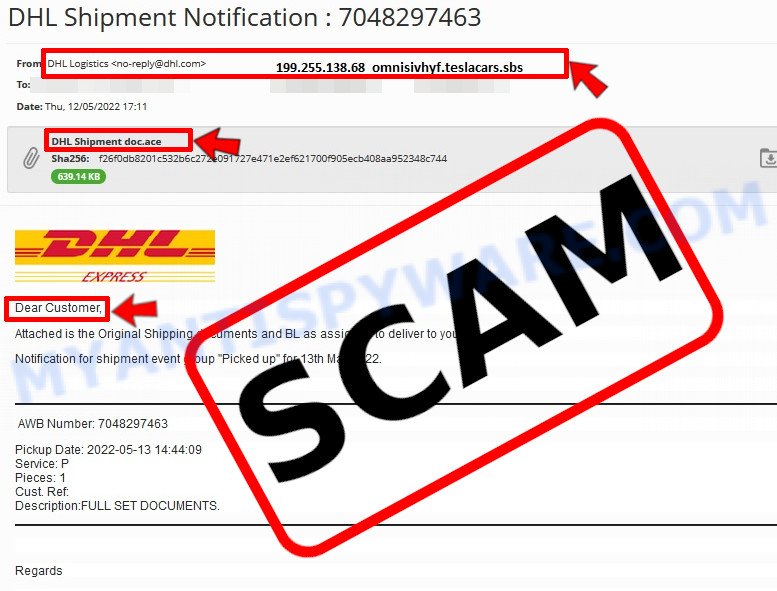
Here are some ways to recognize a phishing email
- Inconsistencies in Email Addresses. The most obvious way how to spot a scam email is finding inconsistencies in email addresses and domain names. If the email claims to be from a reputable company, like Amazon or PayPal, but the email is being sent from a public email domain, such as “gmail.com” it’s probably a scam.
- The domain name is misspelt. Look carefully for any subtle misspellings in the domain name. Like arnazon.com where the “m” has been replaced by “rn”, or paypa1.com, where the “l” has been replaced by “1”. These are common tricks of scammers.
- Generic greetings. If the email starts with a generic “Dear”, “Dear sir” or “Dear madam” that is a warning sign that it might not really be your shopping site or bank.
- Suspicious links. If you have the slightest suspicion an email may be a scam, do not click on the links you see. Instead, hover over the link, but don’t click it. This will pop up a small box that contains the actual URL. This works on image links as well as text links.
- Unexpected attachments. Email attachments should always be verified before clicking. Any attachments should be scanned for viruses – especially if they have an unfamiliar extension or one commonly associated with malware (.zip, .exe, .scr, etc.).
- The email creates a sense of urgency. Creating a false sense of urgency is a common trick of phishing emails. Be suspicious of emails that claim you must call, open an attachment or click a link immediately.
Report Scam Email
If you receive a scam email that is similar but not the same as the example above, make sure you remove any personal info in this message, then post it as comment on this article. This helps us to warn users about current scams, monitor trends and disrupt scams where possible.
